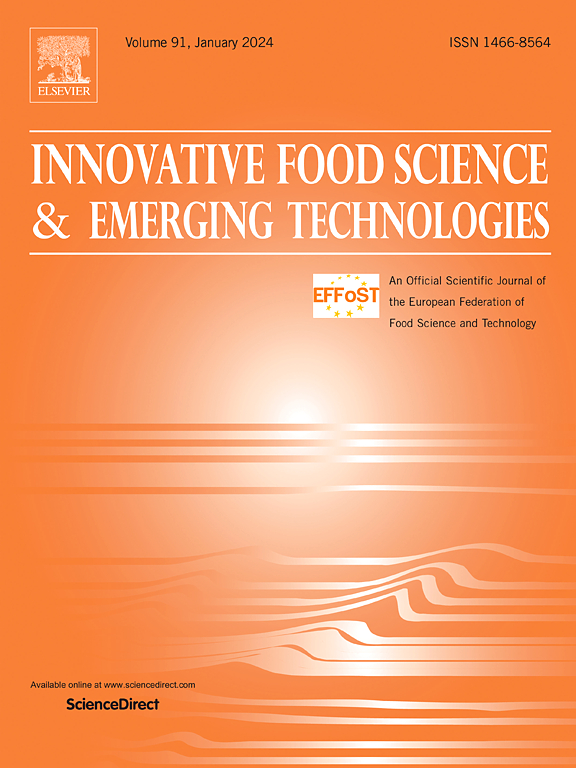From printability to palatability: A sensory and hedonic study of 3D-printed cereal- and legume-based products
IF 6.3
1区 农林科学
Q1 FOOD SCIENCE & TECHNOLOGY
Innovative Food Science & Emerging Technologies
Pub Date : 2025-06-07
DOI:10.1016/j.ifset.2025.104078
引用次数: 0
Abstract
This study focused on generating formulas with high 3D-printability, nutritious values and appreciated by consumers. Earlier studies developed a thermomechanical treatment to make wheat flour printable, which was then optimized for rye and soy flours to vary the nutritional composition of the printed products, in particular their protein and fiber content. However, few studies have looked at consumers' sensory perceptions and preferences towards printed products. In this study, recipes based on wheat, rye or soy flour were taste-enhanced by the addition of cinnamon and apple puree. A sensory and hedonic characterization approach was then implemented to better understand the sensory criteria associated with each of these flours. By evaluating 7 products with two descriptive methods, we found that rye-based products are less compact and with cinnamon smell moderately pronounced. Soy-based products have less deformation, they are more compact and grainier with less sweetness. Wheat-based products are less hard, more humid, moderately compact and have a stronger cinnamon smell. Hedonic evaluation showed that soy products have the best visual appreciation but the worst textural appreciation. By using PREFMAP method combining sensory description by panelists and hedonic evaluation, we noticed that wheat flour products are consumers favorite (80–95 %), followed by rye (35–50 %) and soy (10–20 %). There is little difference in appreciation of products with or without apple puree (< 10 %). This approach provides sensory and hedonic information that will be crucial in establishing a reasoned approach to flour blend formulation in a future study.
从可印刷性到适口性:3d打印谷物和豆类产品的感官和享乐研究
本研究的重点是生成具有高3d打印性,营养价值和消费者欣赏的配方。早期的研究开发了一种热机械处理方法,使小麦粉可打印,然后对黑麦和豆粉进行了优化,以改变打印产品的营养成分,特别是它们的蛋白质和纤维含量。然而,很少有研究关注消费者对印刷产品的感官感知和偏好。在这项研究中,以小麦、黑麦或大豆粉为基础的食谱通过添加肉桂和苹果泥来增强味道。然后实施了一种感官和享乐表征方法,以更好地理解与每种面粉相关的感官标准。通过用两种描述方法评估7种产品,我们发现黑麦基产品不太紧凑,肉桂气味适中。以大豆为基础的产品变形更小,更致密,颗粒状,甜味更低。以小麦为基础的产品不那么硬,更潮湿,适度紧凑,有更强的肉桂味。享乐评价结果表明,豆制品的视觉欣赏效果最好,而质感欣赏效果最差。通过premap方法结合小组成员的感官描述和享乐评价,我们发现小麦粉产品是消费者的最爱(80 - 95%),其次是黑麦(35 - 50%)和大豆(10 - 20%)。对含有或不含苹果泥的产品的评价差别不大(<;10%)。这种方法提供了感官和享乐的信息,这将是至关重要的建立一个合理的方法面粉混合配方在未来的研究。
本文章由计算机程序翻译,如有差异,请以英文原文为准。
求助全文
约1分钟内获得全文
求助全文
来源期刊
CiteScore
12.00
自引率
6.10%
发文量
259
审稿时长
25 days
期刊介绍:
Innovative Food Science and Emerging Technologies (IFSET) aims to provide the highest quality original contributions and few, mainly upon invitation, reviews on and highly innovative developments in food science and emerging food process technologies. The significance of the results either for the science community or for industrial R&D groups must be specified. Papers submitted must be of highest scientific quality and only those advancing current scientific knowledge and understanding or with technical relevance will be considered.

 求助内容:
求助内容: 应助结果提醒方式:
应助结果提醒方式:


